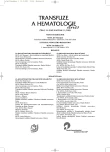Hereditary hemochromatosis
Authors:
J. Novotný 1,2; P. Smejkal 1; Z. Čech 1
Authors‘ workplace:
Oddělení klinické hematologie FN Brno
1; Transfuzní oddělení a krevní banka FN Brno
2
Published in:
Transfuze Hematol. dnes,11, 2005, No. 3, p. 87-97.
Category:
Comprehensive Reports, Original Papers, Case Reports
Overview
Iron is an ubiquitously ocurring vital element which can be found in all living cell from bacterias and yeast to mammals. The cells explore the redox potential of iron, which can be used in many essential and vital biochemical reactions. The iron homeostasis must be very finely tuned beacuse iron overload may lead to the generation of very toxic reactive oxid radicals, which may damage lipids, proteins and nucleic acids with possible severe cellular damage and death. Iron homeostasis is maintained on cellular and whole body levels and details of this fascinating network are disclosed only very recently. Hereditary hemochromatosis was firstly described in the 19th century as so called bronze diabetes. It was the full penetrance of hereditary iron overload, which affected the parenchymatous organs, heart, joints, skin and endocrine glands. The main candidate gene was firstly described in 1966 by Feder et al. and was called HFE gene. HFE gene maps to the 6th chromosome close to the HLA locuses and reveals some homology with the MHC genes. More than 30 mutations and polymorphisms in the HFE gene were discovered, the most frequent are the point mutations C282Y, H63D, and S65C. The most frequent genetic basis of hereditary hemochromatosis in caucasoids is the C282Y mutation, prevalence of heterozygotes in the caucasoid populations being from 5 to 12 percent. The C282Y mutation can be revealed in about 80% of caucasoid patients with the diagnosis of hereditary hemochromatosis. The classic hereditary hemochromatosis represents the autosomal recessive trait with incomplete penetrance, which is estimated in the broad interval from 1 to 50 percent. The mutations in other genes, which code for other proteins of iron metabolism, were discovered. This mutations cause so called non-HFE hemochromatosies. The clinical picture of these deseases may be other than the picture of classic hemochromatosis, some the non-HFE iron overloads may be inherited in the dominant manner. The most frequently disscussed topic today is the exact mechanism/ s leading to iron overload in HFE and non-HFE hemochromatosis, the genetic screening for HFE mutations in general population at risk and the relation of iron overload to atherosclerosis, diabetes and malignant diseases.
Key words:
iron, iron overload, HFE mutations, hereditary hemochromatosis
Labels
Haematology Internal medicine Clinical oncologyArticle was published in
Transfusion and Haematology Today

2005 Issue 3
Most read in this issue
- Hereditary hemochromatosis
- Benefit of the different sensitivity of aPTT reagent for diagnosis of lupus anticoagulant inhibitor
- LDL apheresis – evaluation of the results from 1000 performed procedures
- Detection of minimal residual disease in acute lymphoblastic leukemia using quantification of immunoglobulin and T-cell receptor genes rearrangements. How to avoid misinterpretation of the results
